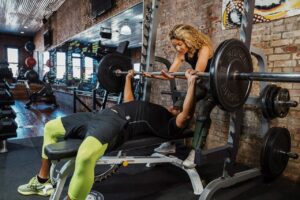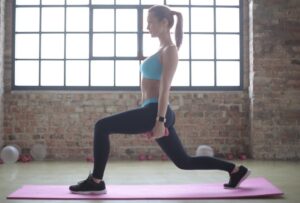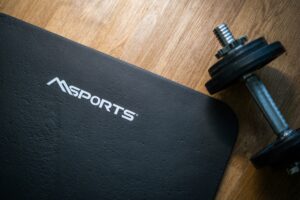Pull exercises are one of several types of activities you can perform to strengthen and develop your body.
As their name implies, these activities involve bringing an external weight to yourself or pulling your body toward a sturdy external object.
Two examples are dumbbell rows, where you pull the external weight to yourself, and pull-ups, where you pull your body upward while holding onto a horizontal bar.
Pull exercises primarily focus on the back complex and your biceps. Back muscles like the latissimus dorsi (lats) do most of the work, whereas the biceps assist and contribute to elbow flexion.
Let’s review a list of pull exercises you can add to your training program.
8 Effective Pull Exercises
1. Pull Up and Chin Up
Pull-ups and chin-ups are two of the best exercises you can include in pull workouts to develop a broad and strong back (1).
The objective is to grab a horizontal bar and use your upper body muscles to pull yourself up until your chin is over the bar.
People who lack the strength for regular pull-ups and chin-ups can begin with slow negatives. Raise yourself to the top position by jumping or stepping on something and control yourself on the way down, extending your arms as slowly as possible.
Doing so allows you to overload your muscles eccentrically and provides the necessary stimulus to build strength for regular pull-ups.
How to (pull-up):
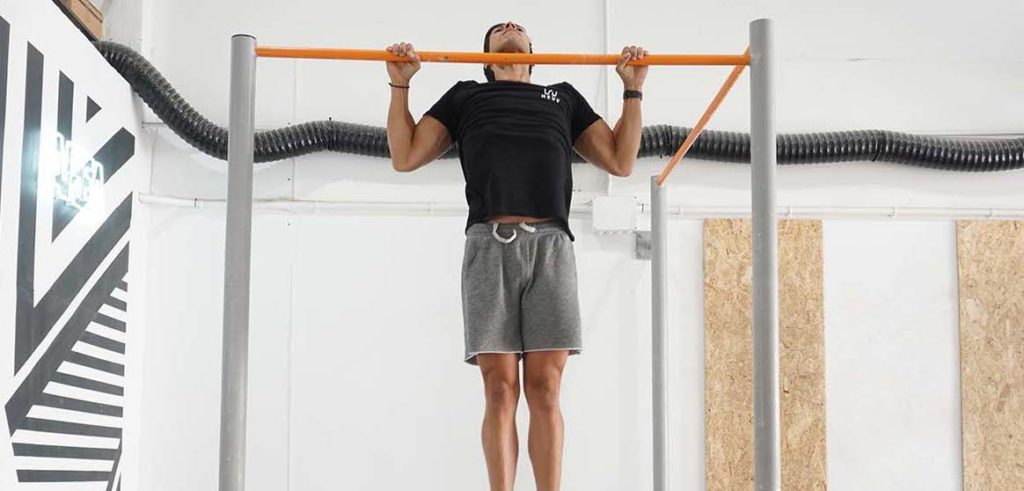
- Reach up and grab a pull-up bar with an overhand grip (palms facing forward). Your hands should be slightly more than shoulder-width apart.
- Retract your shoulder blades, engage your midsection, squeeze your buttocks, and inhale.
- Bend your knees slightly to suspend yourself in the air.
- Pull yourself up in one fluid motion. Move up until your chin is over the bar.
- Pause at the top for a moment and slowly lower yourself. Keep your body stable and avoid swinging back and forth.
- Go down until your arms are almost straight, and exhale near the bottom.
- Take another breath and pull yourself up again.
How to (chin-up):
Follow the same instructions but use an underhand grip (palms facing back) and have your hands slightly closer (roughly shoulder-width apart).
Pro tip:
Chin-ups and pull-ups are challenging bodyweight pull exercises that take time to master. Too many trainees attempt to rush through the progression only to do half reps or use jerking motions.
Be patient and employ intelligent progression tactics to develop a strong and technically impressive pull-up. Here’s an example:
- Start with slow negatives.
- Proceed to band-assisted pull-ups. Loop a resistance band over a pull-up bar, let it hang like a noose, and put your feet inside to reduce the difficulty and practice proper form. You can start with a tougher band that removes more resistance and gradually move to thinner ones that offer less support.
- Include some inverted rows in your program. We will discuss these and their application below.
Most importantly, train through a full range of motion and maintain proper form by following our instructions from above.
Related article: 10 Short Head Bicep Exercises for Thick Upper Arms
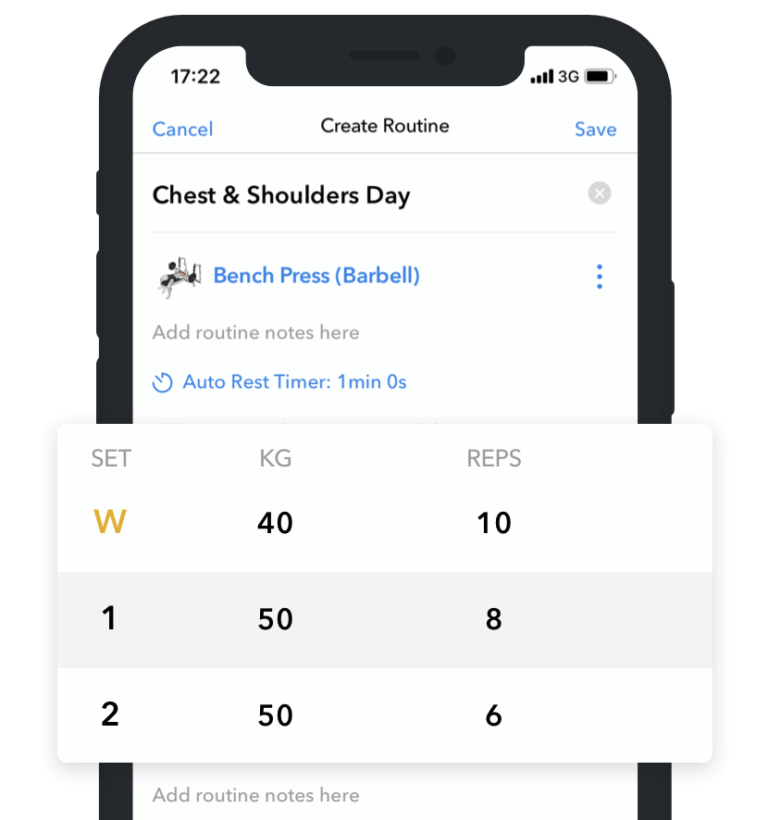
Hevy – Workout Tracker





Hevy – Workout Tracker
Create and log your pull exercises with Hevy, and track your progress
2. Bent Over Row (Barbell)
Bent-over rows are one of the classic back exercises that bodybuilders and gym-goers have used for decades.
The objective is to grab a loaded barbell, lean your torso forward, and repeatedly pull it to your stomach. Doing so strengthens and develops the back, midsection, biceps, and forearms.
One notable benefit of the bent-over row is its excellent overloading potential. New trainees can start with an empty bar and gradually add weight as they get stronger. It’s not uncommon to eventually train with 200 or even 300 pounds.
Another benefit of the barbell row is that it offers a decent range of motion, promoting a good muscle stretch as you lower the bar and a strong contraction as you pull.
Still, the movement is slightly controversial because some trainees round their lower back, which can stress the spine and lead to pain. The best ways to avoid such a possibility are to train with weights you can control and remain mindful of your body position on every set.
How to:
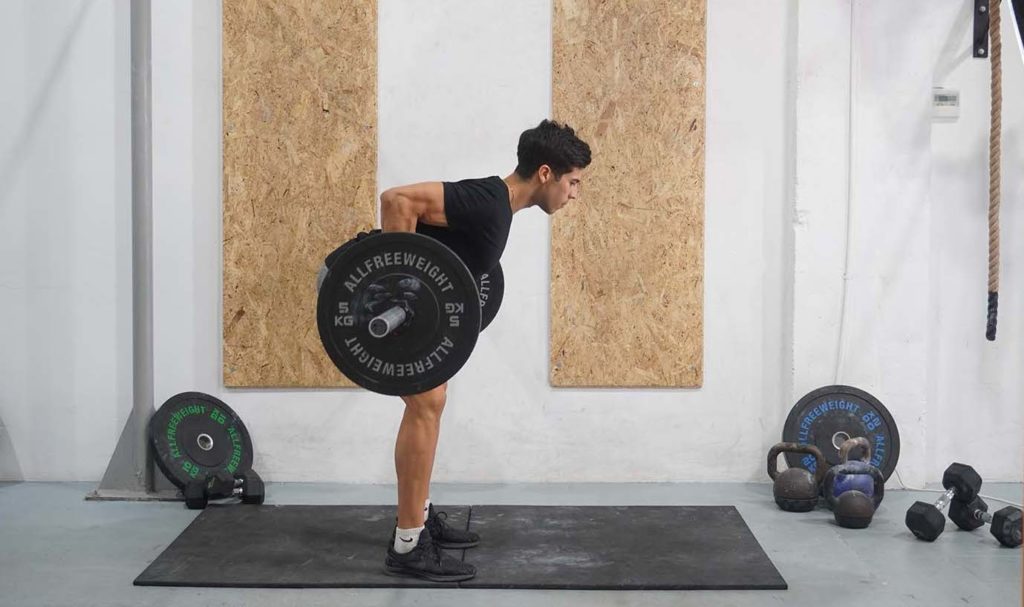

- Stand in front of a loaded barbell, lean forward, and grab it with a double overhand grip (palms facing back). Your hands should be roughly shoulder-width apart.
(You can also use an underhand grip where your palms face forward. However, doing so puts greater emphasis on the biceps.) - Bring your chest out and engage your midsection. The bar should be close to your shins.
- Lift the barbell as you would during a straight (stiff) leg deadlift, and stand tall.
- Bring your shoulders back, have your feet roughly shoulder-width apart, engage your abs, and inhale.
- Hinge at the hips by bringing your buttocks back and lean your torso forward. Your torso should be nearly parallel to the floor with your arms straight and hanging vertically.
- Inhale and row the bar to mid-stomach level in one fluid motion.
- Pause at the top for a moment and slowly extend your arms as you exhale.
- Take another breath and pull the bar again. Keep your torso in the same position; the only movement should occur at your elbows and shoulders.
Pro tip:
A common error is loading up more weight than you can handle. Doing so forces you to maintain a more upright torso position, turning the row into a modified barbell shrug. In addition, it shortens the range of motion and often causes trainees to jerk the barbell to do more reps.
Aside from making the exercise much less effective, using too much weight puts you at risk of injuries, especially if your lower back rounds.
Save yourself the trouble and get the most out of barbell rows by using weights you can handle with proper form. You should be able to pull the bar in one fluid motion without using momentum or moving your torso up and down.
Trainees new to the exercise can aim for up to 15 reps per set to master the proper technique. In contrast, more advanced lifters can do as few as 6 to 8 reps.
3. Dumbbell Row
Dumbbell rows are among the most practical and effective pull day exercises, offering some unique benefits.
Most notably, dumbbells force both sides of your body to work independently, reducing the risk of muscle imbalances. In contrast, the more dominant side can take over and do most of the work during barbell activities, causing the weaker side to remain smaller and underdeveloped.
In addition, dumbbells allow for a slightly longer range of motion. You can pull the weights slightly higher because your torso doesn’t get in the way. As a result, you can squeeze your back and biceps more effectively at the top position, improving muscle activation.
How to:
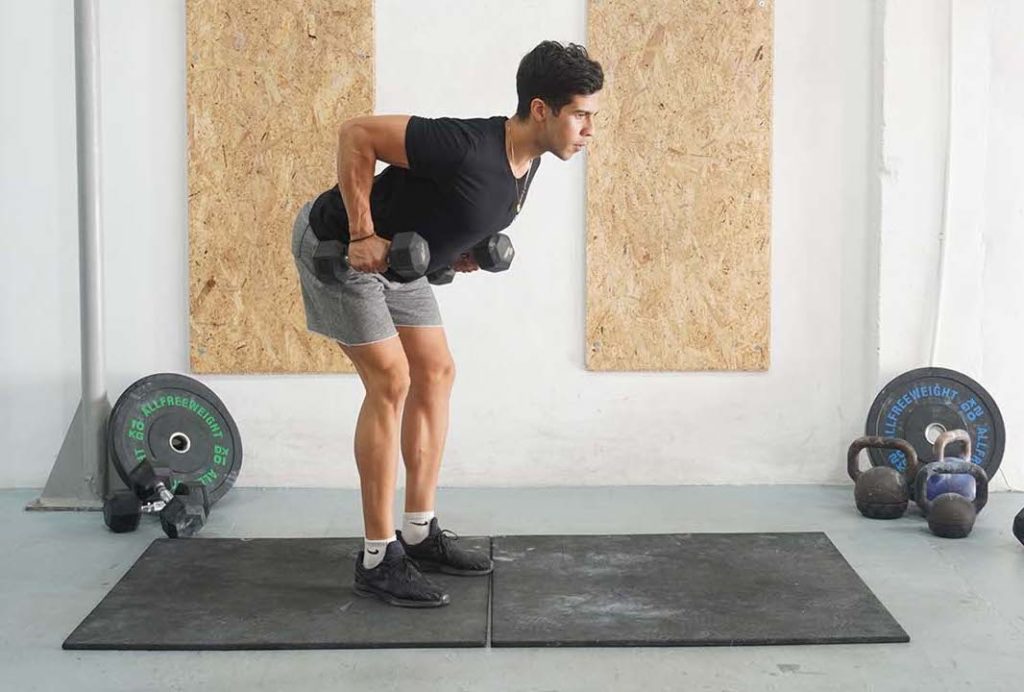

- Hold a dumbbell in your right hand and stand in front of a flat gym bench.
- Place your left knee on the edge of the gym bench.
- Lean your torso forward and position your left hand flat on the bench for support with your arm extended.
- Engage your abs and retract your shoulder blades to straighten your back. Your right arm should hang straight down.
- Inhale and row the dumbbell, keeping your elbow close to your body. Pull until your elbow is at torso level or slightly higher, and squeeze your back muscles at the top.
- Slowly lower the weight by extending your arm. Keep your shoulder blades retracted and exhale near the bottom.
Once finished, grab the dumbbell with your left hand, position your right side over the flat gym bench, and perform the same number of reps.
Pro tip:
One of the most common mistakes trainees make with the dumbbell row is using too much weight. Doing so leads to excessive swinging and the use of momentum to complete more reps, taking the tension away from the lats and biceps.
While technically a compound exercise, it is more beneficial to perform dumbbell rows with a lighter weight that allows you to train through a full range of motion and do at least 8 to 10 reps per set.
Slow and controlled repetitions improve muscle activation and allow you to train the back more effectively.
4. Inverted Row
Inverted rows, also known as body rows, are an effective bodyweight exercise you can include in a pull workout for mass.
Similar to pull-ups, your body weight provides resistance. But instead of pulling yourself up vertically, you maintain a more horizontal body position and keep your feet on the floor from start to finish.
A practical way to perform the exercise is on a Smith machine. You can set the bar to the preferred height, secure it, and feel stable during each set.
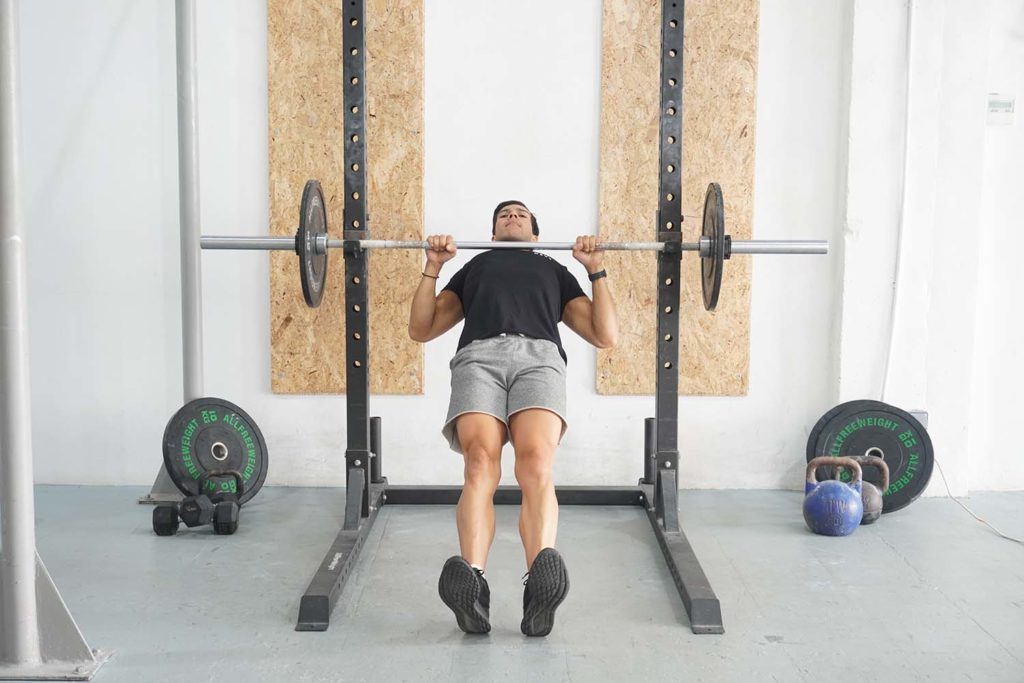

How to:
- Set a Smith machine bar at the preferred height (roughly mid-stomach level for most people). Alternatively, secure a barbell inside a squat rack and use it for your inverted rows.
- Grab the bar with an overhand grip (palms facing down) and have your hands roughly shoulder-width apart.
- Tuck yourself under the bar, extending your body. Support your lower body on your heels or bend your knees and have your feet flat on the ground.
- With your arms straight, retract your shoulder blades, engage your abs, and squeeze your glutes. Maintain a more upright body position if you’re new to the exercise. A more horizontal position makes the exercise more challenging.
- Pull yourself up, bringing your chest to the bar and pausing at the top.
- Slowly lower yourself as you fully extend your arms. Exhale near the bottom.
Pro tip:
Inverted rows are one of the most useful exercises to develop back strength and work up to your first pull-up or chin-up (2).
Beginners can do the exercise with an almost upright body position and gradually become more horizontal as they get stronger. At some point, you can even elevate your feet on a plyo box or gym bench to increase the resistance.
Related article: Back and Bicep Workouts for Building Strength
5. Pendlay Row
Pendlay rows are a popular barbell pull activity. The exercise is named after the late Glenn Pendlay, a renowned weightlifting coach in America.
Like a bent-over row, trainees must pull a barbell to train their back, midsection, and biceps. The difference is that instead of keeping the bar in the air, you must set it on the floor after each repetition and pull from a dead stop.
Setting the bar on the floor between reps limits lumbar stress, making the exercise useful for people with back issues.
In addition, pulling from a dead stop reduces the likelihood of using momentum and keeps you more aware of your torso position.
A notable issue with bent-over rows is that trainees become too upright, turning the exercise into a modified shrug. In contrast, Pendlay rows force you to adjust your torso position multiple times, making you less likely to become too upright.
How to:
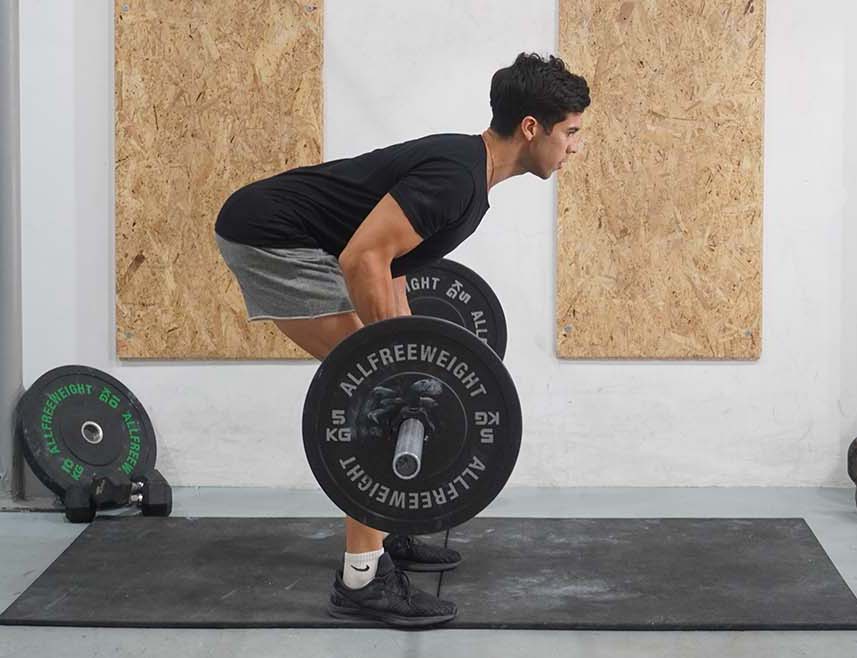

- Set a loaded barbell on the ground and stand in front of it.
- Lean forward and grab the bar with an overhand grip (palms facing back). Your shins should be a few inches from the bar.
- Bend your knees slightly and retract your shoulder blades to straighten your back.
- Squeeze your abs and inhale.
- Pull the barbell from the ground to your upper stomach in one fluid motion and pause at the top, squeezing your back.
- Slowly lower the bar to the starting position, gently setting it on the floor as you exhale.
Pro tip:
Picking the correct load for Pendlay rows can take time and effort. Some trainees add too much weight and end up yanking the bar. Doing so can be useful for improving power production under some circumstances, but it isn’t ideal for hypertrophy.
The correct weight is one you can lift for at least 6 to 8 reps without using momentum. You should be able to pull the bar to your torso in one smooth motion and pause at the top for a moment.
6. Renegade Row
Renegade rows are a full-body exercise that develops strength, balance, and unilateral strength.
To perform the exercise, you should ideally use a pair of hexagonal dumbbells or kettlebells, allowing you to maintain a solid position.
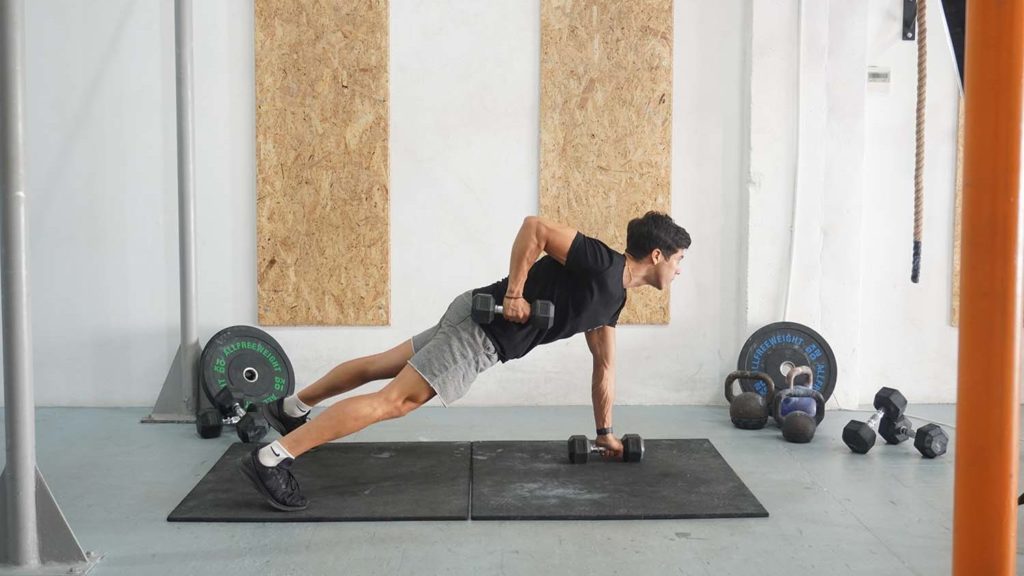

How to:
- Grab a pair of hexagonal dumbbells or kettlebells and get down on your knees.
- Position the weights roughly shoulder-width apart with the handles parallel.
- Extend your body into a high-plank/push-up position and squeeze your abs to keep your body stable and prevent your lower back from arching.
- Bring your shoulders back, inhale, and tilt slightly to your left.
- Pull the weight in your right hand up, bringing your elbow to torso level or slightly higher.
- Pause at the top for a moment and slowly lower the weight as you exhale.
- Inhale again and repeat.
- Once finished training your right side, tilt your body to the right, and do the same number of reps for your left side.
Pro tip:
One common mistake trainees make during Renegade rows is twisting their hips while pulling the weight up. Doing so can lead to some instability and reduce the overall effectiveness of the exercise.
Trainees often twist their hips during Renegade rows because they attempt to use too much weight.
A simple fix to the mistake is to use lighter weights you can control. Tilt your body slightly to one side and pull the weight with your opposite arm smoothly and without using jerking motions.
7. Chest-Supported Incline Row (Dumbbell)
Chest-supported incline rows are a less common strength exercise with some unique benefits.
Like a dumbbell row, the chest-supported variation trains both sides of your body equally, reducing the risk of muscle imbalances.
First, you can more easily spot imbalances. For example, if you can row a weight for 10 reps on your right side but can only do 6 or 7 reps for your left, it likely indicates an imbalance that needs addressing.
Second, using dumbbells means your stronger side cannot take over and make up for the weaker one to further contribute to imbalances. Both sides work equally to complete the same number of reps.
How to:
- Grab a pair of dumbbells and lie face down on an incline gym bench with your stomach against the back support and feet planted on the floor.
- Straighten your arms and position them to your sides to hang straight down.
- Retract your shoulder blades, squeeze your glutes, inhale, and tense your midsection.
- Row both dumbbells simultaneously until your elbows are at torso level. You can keep your elbows to your sides or flare them slightly––both variations work.
- Pause at the top position and slowly extend your arms without letting your shoulder blades protract (roll forward). Exhale near the bottom.
- Inhale again and repeat.
Pro tip:
The exercise isn’t that challenging, but trainees sometimes struggle with the setup.
If you’re using heavier dumbbells and cannot hold them while setting up, place them on the floor, lie face down on the bench, and grab them for your set. You can place the weights on an elevated object (e.g., a plyo box) to reach them more easily.
Related article: The Ultimate Dumbbell Back Workout for Strength and Ripped Muscles
8. Seated Cable Row
Seated cable rows are a compound assistance exercise you can include in good pull workouts.
Unlike some of the movements on our list, cable rows are more beginner-friendly but offer similar benefits:
- Excellent range of motion
- Impressive overloading potential
- Training all major back muscles and the biceps
In addition, cables provide constant tension, improving muscle activation and possibly contributing to more growth.
How to:
- Select the appropriate load and attach the preferred handle type. For example, a double-grip V-handle works well for this exercise, but you can use a wider one if you prefer.
- Sit down and position your feet on the platform.
- Bend your knees slightly, lean forward, grab the handle, and lean slightly back.
- Retract your shoulder blades, inhale, and tense your midsection.
- Pull the handle to your stomach in one fluid motion.
- Pause for a moment and slowly extend your arms as you exhale.
Pro tip:
Avoid using too much weight, as that can lead to excessive swinging. You should be able to do at least ten smooth and controlled repetitions where your torso remains in a stable position from start to finish.
Some trainees use too much weight and move their torso back and forth, taking the tension away from the upper back and turning the exercise into a hip hinge.
Related article: Back Cable Workouts for Every Level: Beginner, Intermediate, and Advanced
Frequently Asked Questions (FAQs)
1. What constitutes a good pull workout?
The best pull day workouts include several exercises, allowing you to train your back from multiple angles and leverage various intensity zones (repetition ranges).
For example, you can start with heavy pull-ups, do moderately-heavy barbell rows, and proceed to dumbbell and seated cable rows with lighter weights.
2. Is the deadlift a push or pull?
Deadlifts are a pull exercise because the objective is to lift a heavy weight from the floor through a combination of pulling and hip extension. The only push involved in the exercise is early in each repetition when you dig your heels into the floor to generate force.
3. Are four exercises for pull day enough?
It largely depends on your training split and how frequently you train your back. In most cases, four exercises are ideal.
4. Can I have an effective pull workout at home?
While more challenging, it is possible.
You can do pull-ups on a home pull-up bar, inverted rows underneath a sturdy table, dumbbell exercises, and resistance band activities.
Final Thoughts
Pull exercises are crucial for back and bicep strength, upper body aesthetics, good posture, and physical functionality.
The above eight are some of the best pull exercises you should add to your training, but there are plenty of other activities to consider.





Hevy – Workout Tracker





Hevy – Workout Tracker
Create and log your pull exercises with Hevy, and track your progress
Check out the Hevy app, which has a rich exercise library featuring more than 380 exercises for all the major muscle groups.


